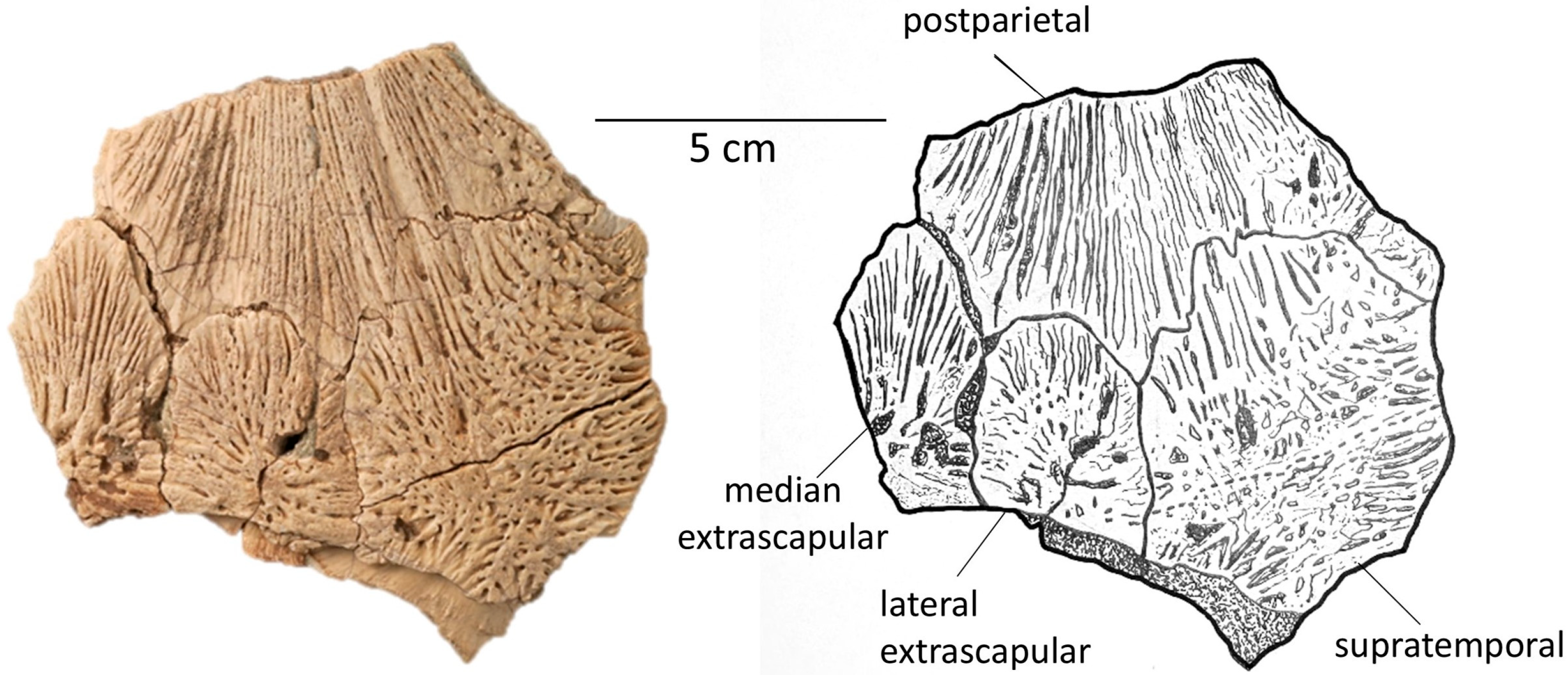An Early Cretaceous Record of the Mawsoniid Coelacanth Axelrodichthys from Niger
Abstract
1. Introduction
2. Materials and Methods
3. Results
3.1. Systematic Paleontology
3.2. Description
4. Discussion
Funding
Data Availability Statement
Acknowledgments
Conflicts of Interest
References
- Maisey, J. Coelacanths from the Lower Cretaceous of Brazil. Am. Mus. Novit. 1986, 2866, 1–30. [Google Scholar]
- Maisey, J. Santana Fossils: An Illustrated Atlas; T.F.H. Publications: Neptune City, NJ, USA, 1991; p. 459. [Google Scholar]
- Fragoso, L.; Brito, P.; Yabumoto, Y. Axelrodichthys araripensis Maisey, 1986 revisited. Hist. Biol. 2018, 31, 1350–1372. [Google Scholar] [CrossRef]
- Cavin, L.; Boudad, L.; Tong, H.; Lang, E.; Tabouelle, J.; Vullo, R. Taxonomic composition and trophic structure of the continental bony fish assemblage from the Early Late Cretaceous of southeastern Morocco. PLoS ONE 2015, 10, e0125786. [Google Scholar] [CrossRef] [PubMed]
- Gottfried, M.D.; Rogers, R.R.; Curry Rogers, K. First record of Late Cretaceous coelacanths from Madagascar. In Recent Advances in the Origin and Early Radiation of Vertebrates; Arratia, G., Wilson, M.V.H., Cloutier, R., Eds.; Verlag Dr. Friedrich Pfeil: Munich, Germany; pp. 687–691.
- Cavin, L.; Valentin, X.; Garcia, G. A new mawsoniid coelacanth (Actinistia) from the Upper Cretaceous of southern France. Cretac. Res. 2016, 62, 65–73. [Google Scholar] [CrossRef]
- Cavin, L.; Buffetaut, E.; Dutour, Y.; Garcia, G.; Le Loeuff, J.; Méchin, A.; Méchin, P.; Tong, H.; Tortosa, T.; Turini, E.; et al. The last known freshwater coelacanths: New Late Cretaceous mawsoniid remains (Osteichthyes: Actinistia) from Southern France. PLoS ONE 2020, 15, e0234183. [Google Scholar] [CrossRef] [PubMed]
- Carvalho, M.S.S.de; Maisey, J. New occurrence of Mawsonia (Sarcopterygii, Actinistia) from the Early Cretaceous of the Sanfranciscana Basin, Minas Gerais, Brazil. In Fishes and the Break-Up of Pangea; Cavin, L., Longbottom, A., Richter, M., Eds.; Geological Society, London, Special Publications: London, UK, 2008; Volume 295, pp. 109–144. [Google Scholar]
- Cavin, L.; Cupello, C.; Yabumoto, Y.; Fragoso, L.; Deesri, U.; Brito, P.M. Phylogeny and evolutionary history of mawsoniid coelacanths. Bull. Kitakyushu Mus. Nat. Hist. Ser. A 2019, 17, 3–13. [Google Scholar]
- Cavin, L.; Tong, H.; Buffetaut, E.; Wongko, K.; Suteethorn, V.; Deesri, U. The first fossil coelacanth from Thailand. Diversity 2023, 15, 286. [Google Scholar] [CrossRef]
- Cavin, L.; Torino, P.; Van Vranken, N.; Carter, B.; Polcyn, M.J.; Winkler, D. The first Late Cretaceous mawsoniid coelacanth (Sarcopterygii: Actinistia) from North America: Evidence of a lineage of extinct ‘living fossils’. PLoS ONE 2021, 16, e0259292. [Google Scholar] [CrossRef] [PubMed]
- Torino, P.; Soto, M.; Perea, D. A comprehensive phylogenetic analysis of coelacanth fishes (Sarcopterygii, Actinistia) with comments on the composition of the Mawsoniidae and Latimeriidae: Evaluating old and new methodological challenges and constraints. Hist. Biol. 2021, 33, 3423–3443. [Google Scholar] [CrossRef]
- Gee, H. Cretaceous unity and diversity. Nature 1988, 332, 487. [Google Scholar] [CrossRef]
- Forey, P.L. History of the Coelacanth Fishes; Chapman & Hall: London, UK, 1998; p. 419. [Google Scholar]
- Forey, P.L.; Grande, L. An African twin to the Brazilian Calamopleurus (Actinopterygii: Amiidae). Zool. J. Linn. Soc. 1998, 123, 179–195. [Google Scholar] [CrossRef]
- Wenz, S. A propos du genre Mawsonia, coelacanthe geant du Cretace Inferieur d’Afrique et du Bresil. Mem. Soc. Geol. Fr. 1980, 59, 187–190. [Google Scholar]
- Buffetaut, E.; Rage, J.-C. Fossil amphibians and reptiles and the Africa-South America connection. In The Africa-South America Connection; George, W., Lacovat, R., Eds.; Oxford Press: Clarendon, UK, 1993; pp. 87–99. [Google Scholar]
- Parmera, T.C.C.; Gallo, V.; Da Silva, H.; De Figueiredo, F.J. Distributional patterns of Aptian-Albian paleoichthyofauna of Brazil and Africa based on track analysis. An. Acad. Basileira Cienc. 2019, 91 (Suppl. 2). [Google Scholar] [CrossRef] [PubMed]
- Reyment, R.A. Biogeography of the Saharan Cretaceous and Paleocene epicontinental transgressions. Cretac. Res. 1980, 1, 299–327. [Google Scholar] [CrossRef]

Disclaimer/Publisher’s Note: The statements, opinions and data contained in all publications are solely those of the individual author(s) and contributor(s) and not of MDPI and/or the editor(s). MDPI and/or the editor(s) disclaim responsibility for any injury to people or property resulting from any ideas, methods, instructions or products referred to in the content. |
© 2025 by the author. Licensee MDPI, Basel, Switzerland. This article is an open access article distributed under the terms and conditions of the Creative Commons Attribution (CC BY) license (https://creativecommons.org/licenses/by/4.0/).
Share and Cite
Gottfried, M.D. An Early Cretaceous Record of the Mawsoniid Coelacanth Axelrodichthys from Niger. Foss. Stud. 2025, 3, 16. https://doi.org/10.3390/fossils3040016
Gottfried MD. An Early Cretaceous Record of the Mawsoniid Coelacanth Axelrodichthys from Niger. Fossil Studies. 2025; 3(4):16. https://doi.org/10.3390/fossils3040016
Chicago/Turabian StyleGottfried, Michael D. 2025. "An Early Cretaceous Record of the Mawsoniid Coelacanth Axelrodichthys from Niger" Fossil Studies 3, no. 4: 16. https://doi.org/10.3390/fossils3040016
APA StyleGottfried, M. D. (2025). An Early Cretaceous Record of the Mawsoniid Coelacanth Axelrodichthys from Niger. Fossil Studies, 3(4), 16. https://doi.org/10.3390/fossils3040016






